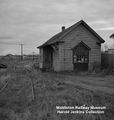Dominion Atlantic Railway Digital Preservation Initiative - Wiki
Use of this site is subject to our Terms & Conditions.
Difference between revisions of "Avonport"
Dan conlin (talk | contribs) (→Description & History: another source) |
Dan conlin (talk | contribs) |
||
| Line 13: | Line 13: | ||
==Description & History== | ==Description & History== | ||
| − | A farming community located between the mouths of the Avon and Gaspreaux Rivers, the community was caleld "Horton Point" until 1864 when the name was changed to "Avonport".<ref>[https://novascotia.ca/archives/places/page.asp?ID=25 C. Bruce Fergusson, "Avonport"], ''Place-Names and Places of Nova Scotia'' Nova Scotia Archives (1967), p. 25-26.</ref> Avonport was an important location during the construction of the [[Windsor and Annapolis Railway]] as it marked the railhead for the construction of the [[Gaspereaux River Bridge]], a challenging crossing which was the last link to be completed for the W&AR in 1869. Avonport initially had a small 9' x 12' shelter and a 10' x 100' platform.<ref>*Alexander MacNab, ''[[Windsor and Annapolis Railway, Report of Alexander MacNab 1873|Windsor and Annapolis Railway, Report of Alexander MacNab Nov 1, 1873]]'', page 21</ref> | + | A farming community located between the mouths of the Avon and Gaspreaux Rivers, the community was caleld "Horton Point" until 1864 when the name was changed to "Avonport".<ref>[https://novascotia.ca/archives/places/page.asp?ID=25 C. Bruce Fergusson, "Avonport"], ''Place-Names and Places of Nova Scotia'' Nova Scotia Archives (1967), p. 25-26.</ref> Avonport was an important location during the construction of the [[Windsor and Annapolis Railway]] as it marked the railhead for the construction of the [[Gaspereaux River Bridge]], a challenging crossing which was the last link to be completed for the W&AR in 1869. Avonport initially had a small 9' x 12' shelter and a 10' x 100' platform.<ref>*Alexander MacNab, ''[[Windsor and Annapolis Railway, Report of Alexander MacNab 1873|Windsor and Annapolis Railway, Report of Alexander MacNab Nov 1, 1873]]'', page 21</ref> The station was first located up the grade from the river where the highway crossed the W&A. The shelter was replaced by a standard W&A style station in 1888 and in 1911-102, the station was moved down the hill to the west where spurs were located to two brickyards. The [[Avonport Station]] was notable for having one of the first female station agents in Canada in its busiest years when it served the two brick works, an apple warehouse and was a regular stop for passengers, including area high school students who took the train to [[Windsor]]. The larger of the two brick works, L. E. Shaw Bricks, was established at Avonport in 1883 as an important DAR customer, before the company moved to the Enfield area along the CNR in the mid 1930s. The station building was later destaffed and in 1955 was sold to become a storage shed and office, leaving Avonport to become a flag stop during the final years of the DAR.<ref>Gordon Haliburton, ''Horton Point: A History of Avonport'', 1998, pages 115-118</ref> |
==Gallery== | ==Gallery== | ||
Revision as of 18:47, 14 October 2018
Avonport, Nova Scotia
Mile 43.45 from Windsor Junction on the Halifax Subdivision (Mile 59.26 from Halifax)
- Next Station East: Hantsport
- Next Station West: Horton Landing
Facilities & Features
- Avonport Station
- L.E. Shaw brickyard
- Walton brickyard
- Apple Warehouse
- Gaspereaux River Bridge
Description & History
A farming community located between the mouths of the Avon and Gaspreaux Rivers, the community was caleld "Horton Point" until 1864 when the name was changed to "Avonport".[1] Avonport was an important location during the construction of the Windsor and Annapolis Railway as it marked the railhead for the construction of the Gaspereaux River Bridge, a challenging crossing which was the last link to be completed for the W&AR in 1869. Avonport initially had a small 9' x 12' shelter and a 10' x 100' platform.[2] The station was first located up the grade from the river where the highway crossed the W&A. The shelter was replaced by a standard W&A style station in 1888 and in 1911-102, the station was moved down the hill to the west where spurs were located to two brickyards. The Avonport Station was notable for having one of the first female station agents in Canada in its busiest years when it served the two brick works, an apple warehouse and was a regular stop for passengers, including area high school students who took the train to Windsor. The larger of the two brick works, L. E. Shaw Bricks, was established at Avonport in 1883 as an important DAR customer, before the company moved to the Enfield area along the CNR in the mid 1930s. The station building was later destaffed and in 1955 was sold to become a storage shed and office, leaving Avonport to become a flag stop during the final years of the DAR.[3]
Gallery
The Gaspereaux River Bridge looking east over the Gaspereaux River at Hortonville with Avonport in the distance.
Avonport old station and station flagstop sign, November 18, 1962.
Avonport old station side view of west end moved to siding as storage shed, November 18, 1962.
Avonport Station trackside view of old station moved to siding, November 18, 1962.
References & Footnotes
- ↑ C. Bruce Fergusson, "Avonport", Place-Names and Places of Nova Scotia Nova Scotia Archives (1967), p. 25-26.
- ↑ *Alexander MacNab, Windsor and Annapolis Railway, Report of Alexander MacNab Nov 1, 1873, page 21
- ↑ Gordon Haliburton, Horton Point: A History of Avonport, 1998, pages 115-118




